Fake or Fortune?
Fake or Fortune? is a BBC One television series which examines the provenance and attribution of notable artworks.[1] Since the first series aired in 2011, Fake or Fortune? has drawn audiences of 5 million viewers in the UK,[2] the highest for an arts show in that country.[3]
| Fake or Fortune? | |
|---|---|
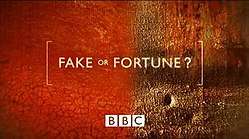 | |
| Genre | Documentary |
| Presented by | Fiona Bruce Philip Mould |
| Country of origin | United Kingdom |
| Original language(s) | English |
| No. of series | 8 |
| No. of episodes | 31 |
| Production | |
| Producer(s) | Simon Shaw |
| Running time | 60 minutes |
| Release | |
| Original network | BBC One |
| Original release | 19 June 2011 – present |
Fake or Fortune? was created by art dealer and art historian Philip Mould and producer Simon Shaw, inspired by Mould's book Sleuth (2009), which was the programme's working title during the development phase.[4] It is co-presented by Mould and journalist Fiona Bruce, with specialist research carried out by Bendor Grosvenor during the first five seasons.[5] Forensic analysis and archival research is carried out by various fine art specialists.[6][7] Each series first aired on BBC One, except the third series accidentally first aired on SVT.[8]
Format
In each episode Philip Mould and Fiona Bruce focus their attention on a painting (or a group of paintings), usually related to one particular artist. They travel around the country and the world, studying the artists at exhibitions, meeting up with international experts and following up local leads. Series 7, episode 5 saw the show tackle their first sculpture, a work attributed to Alberto Giacometti. The team, assisted by Bendor Grosvenor in series 1 to 5, investigate the paintings on a number of fronts: establishing the provenance of the piece by working backwards from present day to the time of the work's creation; on a forensic level, with investigation and scientific tests on the materials used to help establish specific time frames; and examining the unique painting styles and quirks of the artist. This evidence is then presented to established authorities to help demonstrate the legitimacy of the work and its possible addition to the relevant catalogue raisonné.
Series overview
| Series | Episodes | Originally aired | |||
|---|---|---|---|---|---|
| First aired | Last aired | ||||
| 1 | 4 | 19 June 2011 | 10 July 2011 | ||
| 2 | 3 | 16 September 2012 | 30 September 2012 | ||
| 3 | 4 | 19 January 2014 | 9 February 2014 | ||
| 4 | 4 | 5 July 2015 | 26 July 2015 | ||
| 5 | 4 | 17 July 2016 | 28 August 2016 | ||
| 6 | 3 | 20 August 2017 | 10 September 2017 | ||
| 7 | 5 | 12 August 2018 | 9 September 2018 | ||
| 8 | 4 | 25 July 2019 | 15 August 2019 | ||
Episodes
Series 1 (2011)
There were four episodes in the first series, which started on 19 June 2011:
| No. overall | No. in series | Title | Produced and directed by | Original air date | UK viewers (millions) [9] | |
|---|---|---|---|---|---|---|
| 1 | 1 | "Monet" | Nicky Illis | 19 June 2011 | 4.04 | |
| The authenticity of the Monet painting Bords de la Seine à Argenteuil.[10][11] The Wildenstein Institute, presented with considerable evidence of the painting's authenticity, controversially rejected it as a Monet and was criticised by Philip Mould.[12] (The owner subsequently sued the Institute, but lost.[13]) | ||||||
| 2 | 2 | "Homer" | Nicola Lafferty | 26 June 2011 | 3.96 | |
| The ownership of the painting Children Under a Palm by Winslow Homer.[14] | ||||||
| 3 | 3 | "Van Meegeren" | Nicky Illis | 3 July 2011 | 4.1 | |
| The authenticity of the painting The Procuress, owned by the Courtauld Institute. It was determined to be a forgery committed by Han van Meegeren.[15] | ||||||
| 4 | 4 | "Rembrandt" | Ben Southwell | 10 July 2011 | 3.8 | |
| Man in an Oriental Costume, once attributed to Rembrandt as a portrait of the artist's father, was on sale in a gallery in Cape Town, South Africa. The painting was identified as a work looted by the Nazis and was reattributed to Isaac de Jouderville.[16] | ||||||
- Works featured in series 1
 Bords de la Seine à Argenteuil
Bords de la Seine à Argenteuil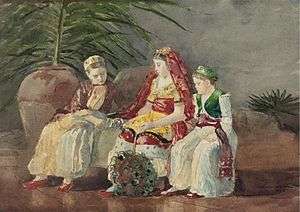 Children Under a Palm Tree
Children Under a Palm Tree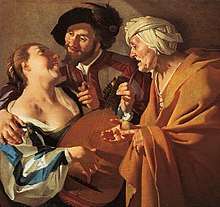 The Procuress
The Procuress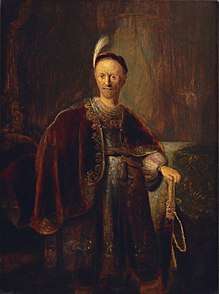 Man in an Oriental Costume
Man in an Oriental Costume
Series 2 (2012)
The first episode of the second series was shown in the UK on 16 September 2012. The series had three episodes:
| No. overall | No. in series | Title | Produced and directed by | Original air date | UK viewers (millions) [9] | |
|---|---|---|---|---|---|---|
| 5 | 1 | "Degas and the Little Dancer" | Robert Murphy | 16 September 2012 | 3.83 | |
| Danseuse Bleue et Contrebasses, with an apparent signature by Edgar Degas. It had been bought as a Degas in 1948 with an outline provenance going back to the artist's studio. Scientific analysis of the paint confirmed that it was consistent with the 1890s. Research confirmed the provenance, and the painting was accepted as an authentic Degas and added to the catalogue raisonne.[17] | ||||||
| 6 | 2 | "Turner: A Miscarriage of Justice?" | Nicky Illis[18] | 23 September 2012 | 4.1 | |
| Three paintings attributed to J. M. W. Turner, The Beacon Light, Off Margate and Margate Jetty, in the collection of the National Museum of Wales.[19] These had been donated by two sisters: Gwendoline and Margaret Davies. In the 1950s, they had been judged to be fake, but as a result of the programme's research, they are now accepted as genuine. | ||||||
| 7 | 3 | "Van Dyck: What Lies Beneath" | Rachel Jardine | 30 September 2012 | 4.37 | |
| A portrait of Queen Henrietta Maria, as St Catherine attributed to Anthony van Dyck, belonging to Mould.[20][21] This was shown to be an incomplete portrait of Queen Henrietta Maria (wife of Charles I) which had later been enlarged and painted over. | ||||||
- Works featured in series 2
 Edgar Degas - Danseuse Bleue et Contrebasses
Edgar Degas - Danseuse Bleue et Contrebasses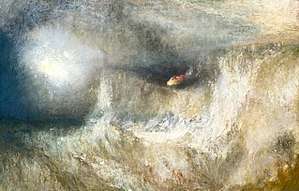 Turner – The Beacon Light
Turner – The Beacon Light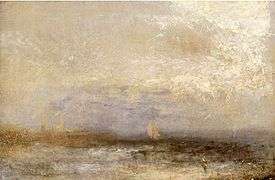 Turner – Off Margate
Turner – Off Margate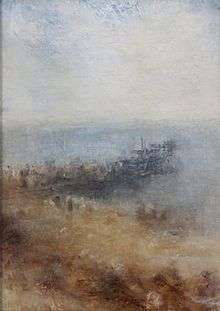 Turner – Margate Jetty
Turner – Margate Jetty.jpg) Van Dyck – Portrait of Queen Henrietta Maria, as St Catherine before restoration
Van Dyck – Portrait of Queen Henrietta Maria, as St Catherine before restoration
Series 3 (2014)
The third series features four episodes. The first episode was first shown on 27 December 2013 on Sweden's SVT, with episodes 2 and 3 shown in the following weeks.[22] Philip Mould described the appearance on Swedish television weeks ahead of the British premiere as a "weird BBC World cock-up".[23] SVT on its website described the programme at the time as a "Brittisk dokumentärserie från 2012" (British documentary from 2012).[24]
| No. overall | No. in series | Title | Produced and directed by | Original air date | UK viewers (millions) [9] | |
|---|---|---|---|---|---|---|
| 8 | 1 | "Vuillard" | Nicky Illis[25] | 19 January 2014 | 4.58 | |
| One of a group of paintings reputedly by French post-impressionist Édouard Vuillard, purchased speculatively by a writer, Keith Tutt. The investigation unearths documentation proving the painting is genuine and worth approximately £250,000.[26] The Wildenstein Institute panel unanimously accepted Tutt's painting as Vuillard's work. The programme also shows that the painting is part of a pair, the other having been sold by the previous owner on eBay.[26] | ||||||
| 9 | 2 | "Constable" | Robert Murphy[27] | 26 January 2014 | N/A | |
| Two different paintings attributed to John Constable,[28] one of Yarmouth Jetty and the other called A Sea Beach Brighton. The former turns out to be "most likely" by Constable, but heavily overpainted by another hand; the latter, formerly in the Boston Museum of Fine Arts until sold in the 1990s, is deemed a genuine Constable.[29][30] | ||||||
| 10 | 3 | "Chagall" | Robert Murphy[31] | 2 February 2014 | 4.48 | |
| Nude, 1909–10 was bought by a Leeds property developer in the belief that it was a genuine but unauthenticated work by Marc Chagall. Forensic tests showed that it was painted with pigments not available at the time it was purported to have been painted. It was submitted to the "Chagall Committee", who ruled that it was a fake and ordered its destruction.[32] | ||||||
| 11 | 4 | "Gainsborough" | Ben Southwell[33] | 9 February 2014 | N/A | |
| The team investigate two paintings from the Your Paintings web site, Imaginary Landscape and Portrait of Joseph Gape, attempting to show they were by Thomas Gainsborough. They successfully convinced Hugh Belsey, the world's leading Gainsborough expert, after he deemed Imaginary Landscape to be a Gainsborough drawing that was reworked in the 19th century, while the portrait was considered a lost Gainsborough painting.[33] | ||||||
- Selected works featured in series 3
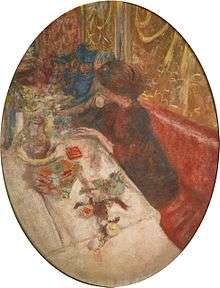 The Café (1918) by Édouard Vuillard
The Café (1918) by Édouard Vuillard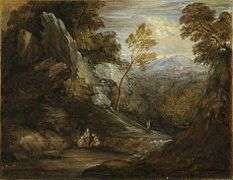 Imaginary Landscape by Thomas Gainsborough
Imaginary Landscape by Thomas Gainsborough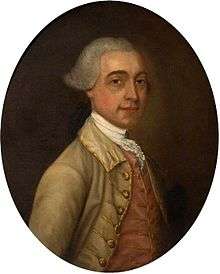 Portrait of Joseph Gape by Thomas Gainsborough
Portrait of Joseph Gape by Thomas Gainsborough
Series 4 (2015)
The series had four episodes:
| No. overall | No. in series | Title | Produced and directed by | Original air date | UK viewers (millions) [9] | |
|---|---|---|---|---|---|---|
| 12 | 1 | "Lowry" | Rachel Jardine[34] | 5 July 2015 | 4.85 | |
| Experts determined whether three works - Lady with Dogs, Darby and Joan and Crowd Scene - were genuine paintings by L. S. Lowry or forgeries. They had been bought in the early 1970s by a Cheshire businessman, Gerald Ames. Lowry was described as "probably the most faked British artist, his deceptively simple style of painting making him a soft target for forgers." Experts analysed the paint used in one of the paintings, but the white paint did not match the flake white Lowry claimed to have always used. Lowry claimed to have only used five colours, flake white (lead white), ivory black, vermillion red, Prussian blue and yellow ochre, produced by Winsor & Newton. Photographic evidence from the 1950s, however, showed that he had experimented with both titanium white and zinc white: Darby and Joan contained traces of zinc white. The same painting was also plainly visible in a contemporary BBC documentary film.[35] | ||||||
| 13 | 2 | "Renoir" | Nicky Illis[36] | 12 July 2015 | 5.3 | |
| Nicky Philipps, an artist noted for her pictures of the royal family, asks the team to investigate a painting which hangs on the walls of Picton Castle, once the Philipps family seat. Two catalogues raisonnés of the works of Renoir disagreed about the authenticity of an unsigned work, known as Boats on the Seine at Argenteuil. Despite an inclusion on the catalogue of Bernheim-Jeune Galerie, the team are unsuccessful in changing the opinion of the Wildenstein Institute. | ||||||
| 14 | 3 | "A Mystery Old Master" | Francis Welch[37] | 19 July 2015 | 4.6 | |
| The team members investigate a painting of the Lamentation of Christ that hangs in St John the Baptist's Church, Tunstall, in Lancashire.[38] After research in Venice and elsewhere, the 16th-century painting is discovered to be by Francesco Montemezzano. It was probably donated to the church in the early 19th century by Frederick Needham (the church's vicar from 1810 to 1816), who was a half-brother of the church's patron, Richard Toulmin North of Thurland Castle.[39] | ||||||
| 15 | 4 | "Munnings and Churchill" | Simon Mansfield[40] | 26 July 2015 | 5.3 | |
|
Charles Henty seeks to validate the provenance of two inherited paintings, one by Alfred Munnings and one, putatively by Winston Churchill, discovered in a coal hole of a house in Ebury Street. Philip Mould visits David Coombs, a leading expert on the art of Churchill, who is unconvinced by the painting on account of the unfamiliarly well painted figures. He is particularly concerned by the colouring which, he feels, is tonally dissimilar to Churchill's accepted oeuvre. In France, the team discover that the painting is of the Fountain of Saint-Paul in Saint-Paul-de-Vence. They are introduced to Joy Lutenbacher, who recalls that her aunt, Joan Smith, witnessed Churchill paint the fountain and provides a signed photo of Churchill given to her aunt, dated October 1945. Bendor Grosvenor also finds supporting evidence in a 1949 newsreel. Despite this evidence, Coombs' initial 'serious misgivings' have not disappeared, and he decides to include the painting in his catalogue raisonné, although only in the 'Mysteries' section. Munnings' painting Dedham Winter Landscape is found to be of a scene which the artist painted more than five times. In a twist of fate, the church depicted in the painting is the final resting place of a notorious art forger, Tom Keating, who was known to have forged Munnings' work. However, this is a mere coincidence and experts Lorian Peralta-Ramos and Dr Bill Teatheredge agree that the painting should be accepted as a work by Munnings. | ||||||
- Selected works featured in series 4
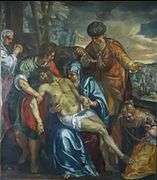 The Deposition by Francesco Montemezzano
The Deposition by Francesco Montemezzano
Series 5 (2016)
Filming for the fifth series started on 24 November 2015.[41] The four-episode series was broadcast on 17 July 2016.[42]
| No. overall | No. in series | Title | Produced and directed by | Original air date | UK viewers (millions) [9] | |
|---|---|---|---|---|---|---|
| 16 | 1 | "Freud" | Rachel Jardine | 17 July 2016 | 4.63 | |
| A portrait purportedly done by Lucian Freud is brought to the attention of the team. However, an outright denial by Freud himself looms over the team; the artist claimed he never painted the artwork under investigation. Faced with repudiating the words of the artist himself, the team trace the painting back to Freud's time during his teenage years at East Anglian School of Painting and Drawing, just before the outbreak of World War II. Fiona finds out through both a previous work's history and through an interview with Freud's daughter that Freud didn't consider works he finished himself to be worthy of his attention, especially ones where someone else had done work on his artwork, suggesting a reason for his denial. Despite the hope of DNA evidence by an embedded hair in the painting not panning out, notes from Freud's solicitor and forensic evidence of the paint and the paint strokes indicate most of the painting was done by one hand, possibly done on an abandoned canvas that already was painted beforehand at the art school Freud attended and then discarded to the side. In the end, when presented with the collected evidence, a panel of three experts on Freud's work deem the painting to have been mostly done by Freud, significantly increasing its value at auction. | ||||||
| 17 | 2 | "Delaroche" | Nicky Illis | 24 July 2016 | 4.84 | |
| A woman asks the team to prove a work, Saint Amelia, Queen of Hungary, housed at Castle of Park in Aberdeenshire, was painted by Paul Delaroche. The painting was acquired by the woman's late husband when he worked for Christie's back in the 1980s, but he never managed to get it authenticated before he died. Delaroche did paint Saint Amelia as a royal commission done for Maria Amalia, wife of Louis Philippe I, before they were deposed in 1848. The artwork could thus be a lost work from the French Revolution of 1848. The alternative Philip needs to investigate is if it is instead a (legitimate) copy done by a contemporary painter, as Delaroche proved popular to replicate. At Claremont in Surrey, where Queen Victoria offered the deposed couple refuge from the Revolution, Bendor reveals that the artwork in question did reach English shores, as it is prominently displayed in an 1866 watercolour of Maria Amalia's bedroom by historical artist Joseph Nash. Differences in colour to known copies of the painting are scientifically explained by pigment degradation. Though the team is unable to establish the provenance between the death of Maria Amalia's son in 1896 and the 1980s purchase, the painting is still deemed to be a genuine Delaroche and the lost work of Maria Amalia. In an 11th hour surprise, the appraiser reveals a letter written by Delaroche where he detailed how he was disgusted at the pitiful state of the picture when he saw it while looking over the commission of a stained glass window version of his artwork and undertook the task of restoring the picture back to its former state, thus explaining the rest of the artefacts revealed by the forensic analysis. The painting was sold via Christie's in July 2019 for £33,750.[43] | ||||||
| 18 | 3 | "Rodin" | Francis Welch | 31 July 2016 | 4.31 | |
| A Lincolnshire resident asks the team to investigate a sketch that is purported to be done by Auguste Rodin. Known primarily for sculptures like The Kiss and The Thinker, Rodin was also accomplished as an artist in other forms, his best known work being a series of sketches of a Cambodian dance troupe that toured in Paris around the turn of the 20th century. The drawing was inherited from the owner's mother while she was living in Mexico in the 1940s after doing some work for the interior of a restaurant. Bendor's research reveals that of an estimated 150 Cambodian sketches done by Rodin, 120 are in the Musee Rodin and 21 authentic works are in other museums, which leaves fewer than 10 in private hands. In addition, Rodin was an often-counterfeited artist in both his sculptures and artwork. The name Ernest Durig pops up in the research: at the time, he was known as a respectable sculptor and art dealer, but long after the drawing was given to the owner's mother, Durig was exposed as a prolific forger of Rodin; his name was most recently at the center of a Rodin sketches forgery scandal at the Musée d'Orsay in 2014. Going to the Musée Rodin, Fiona finds out that the dancers had mesmerized Rodin so much that one series of sketches was done on wrapping paper obtained from a greengrocer, due to his forgetting his sketch paper. When looking at several other sketches, Philip latches on to a particular technique of Rodin, where he blotted the watercolours with minimal strokes while making the dancers seem to be floating. Denied access to a cache of Durig sketches at MoMA for comparison, a signature expert casts more doubt, leading Fiona to reveal that Rodin would leave it up to recipients of his sketches to make their own signature, as he couldn't be cared to sign his works. The appraiser who revealed the Rodin fakes at the Musée d'Orsay deems the sketch to be not by Rodin, but by the forger Durig. | ||||||
| 19 | 4 | "Portraits" | Robert Murphy | 21 August 2016 | 4.22 | |
| As a first for the programme, the team focuses on more than just one work. In this case, three portraits: the first of a young lady that is attributed to Philip Mercier, the second of a formidable-looking man said to have been painted by Adolph von Menzel, and third, a child believed to have been painted by Willem de Kooning. Together with specialist Dr Bendor Grosvenor, they concluded Portrait of a Lady was painted by Mercier (increasing its value from £50 to £5,000), and that The Old General was a clever forgery. In the third case, Portrait of a Child likely was by de Kooning. However, they could not get it authenticated, or even clear up its prior ownership. Unless the current owners can prove the work was not looted in World War II, they don't have the right to sell it. | ||||||
- Selected works featured in series 5
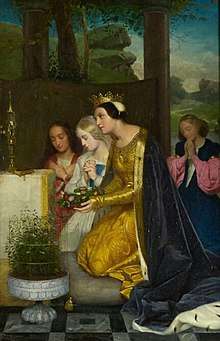
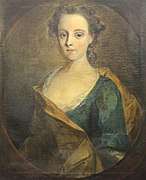 Portrait of a Lady by Philippe Mercier
Portrait of a Lady by Philippe Mercier
Series 6 (2017)
The sixth series started on 20 August 2017.[44] It was originally planned to have four episodes before one, "Giacometti", was postponed.[45]
| No. overall | No. in series | Title | Produced and directed by | Original air date | UK viewers (millions) [9] | |
|---|---|---|---|---|---|---|
| 20 | 1 | "Constable" | Nicky Illis | 20 August 2017 | 5.15 | |
| A painting of Willy Lott's Cottage, previously bought and sold, twice, by Philip Mould is shown to be by John Constable. Mould's previous attempts to prove this had failed to convince experts. Its provenance, from the current owner all the way back to Constable's estate, via the Doheny family,[46] whisky distiller Tommy Dewar and soap manufacturer Thomas J. Barratt, is established. Stylistic details, verified by Constable experts Annie Lyles and Sarah Cove, date the painting to the correct period. Mould, who sold the painting for £35,000 in 2000, is sanguine about losing out on its estimated £2million value.[47] | ||||||
| 21 | 2 | "Tom Roberts" | Francis Welch | 3 September 2017 | 4.57 | |
| Queensland residents Joe and Rosanna Natoli bought a painting with the signature "Tom Roberts" at auction for £7,500. Expert opinion after the purchase, however, was that it was not by the important Australian impressionist of that name. Infrared examination revealed that the back had the title "Rejected", the name Tom Roberts and an address in London's Haymarket that was shown to be Roberts' address while studying at the Royal Academy of Arts. Roberts' sketchbooks showed initial studies which appeared to be preliminaries for the work under investigation. One of the leading authorities on Roberts' work, Mary Eagle of the Art Gallery of New South Wales, accepts it as genuine and Mould values it in excess of £200,000.[48] | ||||||
| 22 | 3 | "Gauguin" | Rachel Jardine | 10 September 2017 | 4.77 | |
|
The team investigate two possible works by Paul Gauguin which have been brought to their attention. One appeared to be the first pencil sketch for Gauguin's Tahitian masterpiece When Will you Marry?. It had been bought by the viewer's art historian grandfather, but its authenticity was in doubt because it appeared to be a copy of a sketch in Gauguin's notebook. The team establish provenance that takes it back to Gauguin and show that it had been cut from the sketchbook sometime between 1916 and 1932. It is accepted as genuine by the Wildenstein Institute. The second possible Gauguin is a still life depicting a bowl of fruit which had been sold as a genuine Gauguin several times and had appeared in a catalogue Raisonne. However, the signature and dedication had been added after the original paint had dried and the signature did not appear genuine. The sale in which it had first appeared included a number of works now attributed to other artists. Connoisseurship also raises doubts about the style and Mould and Bruce conclude that it is not genuine. | ||||||
- Selected works featured in series 6
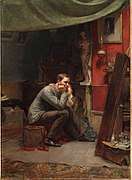 Rejected by Tom Roberts
Rejected by Tom Roberts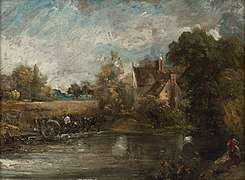
Series 7 (2018)
The seventh series consists of five episodes and started on 12 August 2018.[49]
| No. overall | No. in series | Title | Produced and directed by | Original air date | UK viewers (millions) [9][50] | |
|---|---|---|---|---|---|---|
| 23 | 1 | "Nicholson" | Nicky Illis | 12 August 2018 | 4.21 | |
| A William Nicholson painting, of a glass jug, plates and two pears, was purchased by a collector from the estate of her aunt, Lillian Browse, a respected gallery owner and author of Nicholson's catalogue raisonné. The painting is not included, however, in the current catalogue raisonné compiled by expert Patricia Reed. A wealth of new scientific and documentary evidence was collected, including provenance to a previous wealthy London art-collector, x-ray evidence to show the board had originally borne a painting of freesias (missing from Nicolson's catalogue), and a comparison of the pigments in the paint with traces left in an original painting box owned by Nicolson's grandson. Reed does not change her opinion, however, stating that there is insufficient evidence to show that it was definitely by Nicholson.[49] and not someone working alongside him.[51] | ||||||
| 24 | 2 | "Toulouse-Lautrec" | Rachel Jardine | 19 August 2018 | 4.04 | |
| Two sketchbooks found in a garden shed in Saint-Émilion were given to a teenage boy, Alain, by his grandmother in 1965. Although she never revealed their origin, they were thought to be the work of Henri de Toulouse-Lautrec. Alain waited 50 years before presenting the sketches to the committee responsible for authenticating the work of Toulouse-Lautrec. The committee did not accept them as authentic and concluded they were the work of another artist René Princeteau. The sketchbooks contain images of women, horses, sailors, soldiers and dogs, not the subjects for which Toulouse-Lautrec is best known. Some of the pages are dated 1880, when Toulouse-Lautrec would have been just a teenager. The team travel to Albi in southern France, where Toulouse-Lautrec was born, and visit his family home, Chateau du Bosc, where he spent much of his youth. Compelling technical analysis is provided by print expert Harriet Stratis from Chicago who reports that the sketchbooks match those already known to be by Toulouse-Lautrec and that some sheets have tiny pin-pricks in each corner, which are a distinctive feature of the artist's hand. The committee does not provide a clear decision either way, but offers to re-examine the books at a later date. | ||||||
| 25 | 3 | "Henry Moore" | Lucy Swingler | 26 August 2018 | 4.22 | |
| The team investigate whether a small watercolour sketch could be by the British 20th-century sculptor Henry Moore, thought to be the only piece by a British artist in a private collection of around 1,500 works discovered in Germany in 2012.[52] Known as the Gurlitt Hoard, it is suspected to contain many objects of art looted by the Nazis, and the team is now asked by the Museum of Fine Art in Bern, Switzerland, to find out if the sketch is among these. Philip meets Moore's only child Mary, who says she can see her father's hand in the sketch. Forensic tests on the ink used in the sketch are inconclusive, but infrared analysis reveals more sketches on the back of the paper. Fiona discovers that in the early 1930s Hildebrand Gurlitt, the man who amassed the hoard, worked as a museum curator and exhibited works by Moore who, at the time, was less appreciated at home in Britain. Furthermore, Gurlitt later became one of only four dealers asked to sell off what the Nazis branded as degenerate art on the international market, purchasing some for himself. When the team find an accurate description of the sketch, they can link one of Gurlitt's purchases to what was exhibited years before, thus establishing an unbroken provenance. In the end the Henry Moore Foundation accepts the sketch as a genuine Moore. | ||||||
| 26 | 4 | "A Double Whodunnit" | Francis Welch | 2 September 2018 | 4.35 | |
|
The team investigates two rare portraits of black British subjects from the 18th and 19th centuries, pictures which are highly unusual in their positive depiction of black sitters at a time when Britain was still heavily engaged in slavery. The first case is a double portrait featuring Dido Belle, a former slave who became a member of the aristocratic Mansfield family, and her cousin Lady Elizabeth. The painting is on display at Scone Palace in Scotland and was commissioned by the first Lord Mansfield, Dido Belle's guardian, sometime in the late 1770s or early 1780s. The abolitionist Mansfield, a judge, had ruled in the infamous case of the Zong massacre. The painting's original attribution, to Johan Zoffany, is considered wrong, but the identity of the actual artist is unclear. The second painting, even more unusual, is of two beautifully-dressed black girls holding a book in what appears to be a tropical landscape. Early clues suggest this could be a political painting, perhaps connected to the campaign to abolish slavery in British colonies. The signature was not legible. In the end, forensic and other evidence revealed the first portrait to be by David Martin and the second by Emma Jones. | ||||||
| 27 | 5 | "Giacometti" | Robert Murphy | 9 September 2018 | 3.99 | |
|
Answering the programme's call for works of art other than paintings, Philip and Fiona investigate what appears to be a plaster sculpture of Alberto Giacometti's early work Tête qui regarde (Gazing Head).[53][54] The object shows signs of extensive damage, and a CT scan reveals it has been stapled, stitched and glued back together several times. Philip visits the Sainsbury Centre for Visual Arts at the University of East Anglia, where he learns more about how the cast would have been produced. The investigation leads Fiona to France where the current owner's grandmother modelled at the same time and place where Giacometti worked. Without a clear trail of evidence linking the piece to the sculptor, however, the team changes its approach, and discovers that one of the genuine Gazing Head plasters is considered lost by its British owner, the estate of S. J. Woods, suggesting that it might be possible the piece was purchased from Woods rather than in Paris. When the piece and the collected evidence is presented to the Giacometti Foundation in Paris, the first response is that further studies needed to be made. After several months their provisional findings conclude the piece was once an original sculpture by Giacometti, but that the damage sustained may prevent them from accepting it as a genuine work. This episode was originally scheduled to be broadcast as part of series 6, but was delayed pending the Giacometti Foundation's provisional findings.[54][45] Then the episode was broadcast again right after series 8, on 22 August 2019. In a short added sequence Bruce told the audience that subsequent investigation had found a Giacometti signature on the sculpture. This was followed by onscreen text saying that the work had been auctioned at Christies described as a genuine Giacometti and had been sold for over half a million pounds. It turned out that the owner's cat had knocked it over some fifty years ago, and that the subsequent home repair had covered up the genuine Giacometti signature. Once the signature was found, the Paris Giacometti Committee authenticated the piece, though not in time for the original 2018 screening.[55] | ||||||
![]()
- Selected works featured in series 7
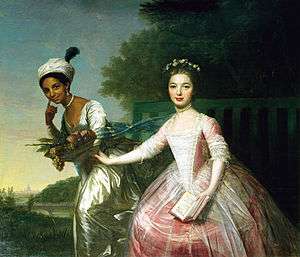 Dido Elizabeth Belle Lindsay and her cousin Lady Elizabeth Murray by David Martin
Dido Elizabeth Belle Lindsay and her cousin Lady Elizabeth Murray by David Martin_Two_Black_Children.jpg) A painting of two black children by Emma Jones
A painting of two black children by Emma Jones
Series 8 (2019)
On 25 July 2019 the eighth series began broadcast.[56][57]
| No. overall | No. in series | Title | Directed by | Producer | Original air date | UK viewers (millions) [50] | |
|---|---|---|---|---|---|---|---|
| 28 | 1 | "The Lost Gainsborough" | Nicky Illis | Nicky Illis | 25 July 2019 | N/A (<3.94)[lower-alpha 1] | |
| The team investigate an oil painting suggested to be the original for the print Wooded landscape with gipsies round a camp fire / The Gipsies, by Thomas Gainsborough. The painting roughly matches the print (once reversed), but it is not an exact mirror image. The painting has been in the owner's family since the 1920s and had originally been attributed to Gainsborough. It had subsequently been down-graded to Barker of Bath and later even further, to a follower of Barker. Mould himself had helped attribute another painting as the lost landscape twenty years ago; a work that subsequently sold as an authentic Gainsborough at auction, so if the team succeed here his earlier work would be undone. Looking at the previously attributed provenance, a label on the back of the frame of the examined work confirmed it as once owned by Henry Graves, and had been exhibited and had also been sold at auction as an original Gainsborough. Infrared and x-ray imaging reveal that the work has been painted on top of a much earlier portrait of a woman; it is suggested that Gainsborough, who was in financial difficulties at that time, had re-used the canvas of a different artist, instead of buying a new one. While this practice was previously unknown for Gainsborough, a recent find confirmed that he had indeed re-used an old canvas for a work confirmed as his. Microscopic analysis of the paint used does not find any modern pigments that would have revealed it as a modern fake. In the end, expert appraisal of the painting technique, by Gainsborough expert Hugh Belsey, established that the work is by Barker of Bath after all, and not Gainsborough. It is later revealed that the portrait hidden beneath the landscape was almost certainly by Michael Dahl (1659–1743), and ironically worth more than the Barker landscape. | |||||||
| 29 | 2 | "Cosway or Lawrence?" | Lucy Swingler | Lucy Swingler | 1 August 2019 | N/A (<3.56)[lower-alpha 1] | |
|
The team investigate a portrait of Peniston Lamb II, owned by the Cecil family, distant relatives of Peniston himself. Philip Mould had chanced upon the work at the family's home in London, and had immediately suspected it was by Thomas Lawrence. Its owners, however, had always believed it was by Maria Cosway. The portrait of Lamb had been shown in an exhibition of Cosway's works in 1895, and had been attributed to her in the following year, in the book Portraits at Panshanger by Victorian art historian Mary Boyle | |||||||
| 30 | 3 | "De Chirico" | Guy Arthur | Christopher Boreham | 8 August 2019 | N/A (<3.84)[lower-alpha 1] | |
|
Fiona and Philip visit a local art dealer who had bought an unusual still life for £1 thirty years ago. He explained a friend had suggested it might be by the Italian surrealist Giorgio de Chirico, and that he had submitted it at the time to the de Chirico foundation in Rome but had had it rejected. Still, the team was persuaded to take another look. Its muted colors suggested it was not painted using oil. A lone walnut had been one reason the foundation rejected the work, but Fiona met with an expert based in Rome who considered its presence very de Chirico. She also unearths the original tempera recipes known to be used by the artist. Back in London, Philip uses technical analysis to confirm the presence of lineseed oil and honey in the paint, highly specific to de Chirico. Meanwhile Fiona explains to the owner their team researched every local lead in the hopes of establishing a provenance trail back from the curio shop where the painting was purchased. However, the only link they found was a British singer who was a friend of de Chirico in the 1950s. As a first for the programme, radio carbon analysis (Carbon-14 dating) that took advantage of the sharp increase in radiocarbon from atmospheric nuclear testing was used to establish that the work was painted on a wooden panel from a tree felled before 1950, thus not disproving the possibility that the singer might have sold off paintings given to her by de Chirico. While this opened up a potential path from Italy to Britain, there was no evidence. With their findings, the team resubmitted the work to the de Chirico foundation. However, the work was not authenticated, the foundation instead suggesting it is an imitation carried out as an exercise, prompting Mould to speculate it must have been painted by someone close to de Chirico. | |||||||
| 31 | 4 | "A Venetian View" | Rachel Jardine | Rachel Jardine | 15 August 2019 | N/A | |
| Nick Hopkinson, publisher of International Boat Industry magazine, believed his great grandparents had bought a view of Venice on a trip to Italy in the 1880s. The painting had been exhibited at the Royal Academy in 1908 and had two "labels" attached to the frame - one attributing it to Jacopo Marieschi, the other attributing it to Francesco Guardi. First off, they established that while Jacopo is now known not to have painted any Venetian views, his father, Michele Marieschi had, and in prolific numbers. At the Royal Academy, the team learned that the Guardi label wasn't official, merely something owners fill in when submitting their works. Thus, all this label tells us is that the owner, Nick's great grandfather Meyer Spielman, believed or wanted to believe the painting was by Guardi. The second label was cut-out from the catalogue entry that had been stuck to the frame, which did suggest the Academy considered it a Marieschi. Then Fiona found an auction catalogue entry that indicated that the work had been sold by Christie's in London in the early 20th century, confirmed by the matching stock number stamped on the frame. Spielman had purchased it as a Marieschi from the estate of a Major Gubbins,[58] making Nick uncomfortable thinking about how his great grandfather then presented it to the Royal Academy as a Guardi. Finally, there was a red seal on the stretcher that the team barely could make out as saying "Firenze". When they travelled to Italy, they found out this indicated the work had been the subject of a specific magistrate's court in Florence before 1808, when Florence was annexed to Napoleonic France. Technical analysis showed that the paints used were all available in the 18th century, however the treatment of the painting's ground layer was inconsistent with Venetian practice and the weave of the canvas suggested it originated in London. The work was examined by Charles Beddington, Britain's foremost authority on Marieschi, who gave the opinion that it was by neither by Guardi or Marieschi, but by an English artist in the 19th century and that the seal had been added to give it a spurious provenance. Philip discussed the difference in valuation: while a work by Marieschi could sell for half a million pounds and a genuine Guardi for £10million, he put a price of £20,000 on Nick's painting. | |||||||
- Selected works featured in series 8
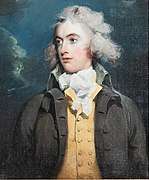 Peniston Lamb II by Thomas Lawrence
Peniston Lamb II by Thomas Lawrence
Reception
Describing the outcome of the first episode of series one as a "scandal", Sam Wollaston writing for The Guardian found the programme "incredibly interesting" and praised it "for being about just one case in which you can become totally involved, instead of flitting between three, which is what so many documentaries seem to do".[59] In The Telegraph, Ceri Radford was described as being "flabbergasted" at the result of the first episode, but concluded her review by saying: "This may have been a disappointing finale, but it at least confirmed that this aesthetically pleasing, quietly enjoyable new series isn't afraid to thwart expectations."[11] Tom Sutcliffe in The Independent had a mixed view as a result of the presentation of the facts, saying: "It was full of cliffhanger tension and thrilling moments of discovery. But I couldn't entirely shift the suspicion that some of it was just a little too good to be true."[60]
The first programme of the third series, shown in the UK on 19 January 2014, had 4.8 million viewers (a 21.8% audience share)[61] while the first programme of the fourth series attracted 4.85m (24.5%).[62]
The record audience for the series was on 12 July 2015 with a peak attendance of 5.8 million viewers (episode 4.2 "Renoir").[63]
Reviewing an episode of the seventh season, Michael Hogan of The Telegraph wrote: "Arts programming is an increasingly endangered beast on prime time television. This absorbing and enjoyable series flies the flag in quietly thrilling fashion."[64]
International broadcasts
The programme had its North American premiere on Canada's TVOntario in 2011.[65] It has also aired on PBS in the United States,[66] and Series 4 has been available on Netflix (as Season 1) since December 2018.[67] The programme airs on ABC in Australia.[68]
Notes
- Not reported in the weekly top 15 programmes for four-screen viewer ratings.
References
- "RTS West of England Awards 2016 | Royal Television Society". rts.org.uk. Retrieved 23 February 2017.
- Brooks, Richard (4 December 2016). "It's a copy: Fake or Fortune? stars try to halt rival show". The Times. Retrieved 26 August 2017.
- "Fake or Fortune". www.bbcstudios.com. Retrieved 4 September 2017.
- "Behind the scenes at Fake or Fortune?". Antiques Trade Gazette.com. Retrieved 12 October 2017.(subscription required)
- "BBC art expert reveals rare painting worth thousands of pounds was destroyed by his cat". telegraph.co.uk. Retrieved 19 April 2019.
- "Fake or Fortune?". BBC Online. Retrieved 4 August 2011.
- "Courtauld advises BBC Fake or Fortune". The Courtauld Institute of Art. 28 July 2015. Retrieved 23 February 2017.
- Grosvenor, Bendor. "Trailer for 'Fake or Fortune?' series 3 - Art History News". Art History News. Retrieved 21 August 2017.
- "Weekly Top 30 Programmes (see relevant week(s))". BARB.
- "Monet". Fake or Fortune?. Series 1. Episode 1. 19 June 2011. BBC. Retrieved 4 August 2011.
- Radford, Ceri (19 June 2011). "Fake or Fortune? BBC One, review". The Telegraph. Retrieved 4 August 2011.
- "Reviews". The Arts Desk. 23 March 2012. Retrieved 27 March 2012.
- Grosvenor, Bendor. "'Fake or Fortune?' Monet owner loses Paris court case". Art History News. Retrieved 7 May 2014.
- "Homer". Fake or Fortune?. Series 1. Episode 2. 26 June 2011. BBC. Retrieved 4 August 2011.
- "Van Meegeren". Fake or Fortune?. Series 1. Episode 3. 3 July 2011. BBC. Retrieved 4 August 2011.
- "Rembrandt". Fake or Fortune?. Series 1. Episode 4. 10 July 2011. BBC. Retrieved 4 August 2011.
- "Degas and the Little Dancer". Fake or Fortune?. Series 2. Episode 1. 16 September 2012. BBC. Retrieved 19 September 2012.
- "Archived copy". Archived from the original on 26 February 2014. Retrieved 23 February 2014.CS1 maint: archived copy as title (link)
- "Turner: A Miscarriage of Justice?". Fake or Fortune?. Series 2. Episode 2. 23 September 2012. BBC. Retrieved 19 September 2012.
- "Van Dyck: What Lies Beneath". Fake or Fortune?. Series 2. Episode 3. 30 September 2012. BBC. Retrieved 5 October 2012.
- Wilson, Benji (16 September 2012). "Van Dyck or Van Dupe?". The Daily Telegraph. Retrieved 19 September 2012.
- "Del 1 av 3 - SVT.se". Svt.se. 30 December 2013. Archived from the original on 30 December 2013. Retrieved 21 August 2017.CS1 maint: BOT: original-url status unknown (link)
- Mould, Philip (4 January 2014). "A weird BBC world cock up but I'm delighted for Sweden. As we've not finished the 4th prog - stranger still". Twitter. Retrieved 26 January 2014.
- "Nya mysterier för experterna i tredje säsongen". Svt.se. Retrieved 21 August 2017.
- "Series 3, Episode 1 listing". Radio Times. Archived from the original on 22 January 2014. Retrieved 21 August 2017.
- "Painting Bought For £3,000 On Ebay Actually Worth A Fortune". Huffington Post. 20 January 2014. Retrieved 24 January 2014.
- "Series 3, Episode 2 listing". Radio Times. Retrieved 21 August 2017.
- "Fake or Fortune series 3". C21media. Retrieved 21 August 2017.
- "Archived copy". Archived from the original on 31 December 2013. Retrieved 30 December 2013.CS1 maint: archived copy as title (link)
- "John Constable". Fake or Fortune. Series 3. Episode 2. 26 January 2014. BBC. Retrieved 26 January 2014.
- "Series 3, Episode 3 listing". Radio Times. Retrieved 21 August 2017.
- Alberge, Dalya (1 February 2014). "The man whose 'real Chagall' could now be burnt as a fake". The Guardian. Retrieved 21 August 2017.
- "Series 3, Episode 4 listing". Radio Times. Retrieved 21 August 2017.
- "Series 4, Episode 1". Radio Times. Retrieved 21 August 2017.
- "BBC iPlayer - Fake or Fortune? - Series 4: 1. Lowry". Bbc.co.uk. 5 July 2015. Retrieved 5 July 2015.
- "Series 4, Episode 2 listing". Radio Times. Retrieved 21 August 2017.
- "A Mystery Old Master, Series 4, Fake or Fortune? - BBC One". BBC. Retrieved 21 August 2017.
- "St John the Baptist, Tunstall". Achurchnearyou.com. Retrieved 15 April 2017.
- A Mystery Old Master, Fake or Fortune, BBC, 19 July 2015
- "Munnings and Churchill, Series 4, Fake or Fortune? - BBC One". BBC. Retrieved 21 August 2017.
- "'Fake or Fortune?' Series 5: Filming Underway". philipmould.com. Retrieved 31 March 2016.
- Mould, Phlip. "Freud or Fake? Day 1 of prog 2, series 5 - due out this summer. Everything to play for #FakeorFortune". twitter.com. Retrieved 31 March 2016.
- Sainte Amélie, Reine de Hongrie – Christie’s.
- "Constable". Fake or Fortune?. Series 6. Episode 1. 20 August 2017. BBC Television. Retrieved 20 August 2017.
- Philip Mould [@philipmould] (10 September 2017). "Apology accepted. Next week's #fakeorfortune(Giacometti) is postponed pending further investigations.TX date to be announced. Repeat instead" (Tweet) – via Twitter.
- Leigh and Lucy Battson
- "Fake or Fortune art expert confronted with £2m Constable masterpiece he sold for just £35,000". The Telegraph. 20 August 2017. Retrieved 20 August 2017.
- Chenery, Susan (3 September 2017). "Lost for 136 years: 'fake' Tom Roberts painting bought for £7,500 could sell for $1m". The Guardian. Retrieved 4 September 2017.
- Johnson, Amy (12 August 2018). "Fake or Fortune: Fiona Bruce left speechless by final verdict as viewers rage". Retrieved 13 August 2018.
- "Four Screen Dashboard (See relevant channel and week(s))". BARB.
- "Nicholson". Fake or Fortune?. Series 7. Episode 1. 12 August 2018. BBC Television. Retrieved 18 August 2018.
- "Is a Drawing in the Gurlitt Hoard an Unknown Early Work by Henry Moore? | artnet News". news.artnet.com. Retrieved 19 April 2019.
- Knights, Emma. "Sainsbury Centre for Visual Arts set to appear in the new series of the Fake or Fortune? television show". Retrieved 28 September 2017.
- "Philip Mould on Twitter: So, this week's #fakeorfortune was designed to go out last year but there were research and authentication issues which meant we were not ready to go. A year on, we are now showing it. Oh, and it is our first three dimensional work of art (in 27 programmes)."". twitter.com. Retrieved 19 April 2019.
- Alberge, Dalya (23 August 2019). "'Worthless' sculpture from BBC's Fake or Fortune proves to be authentic Giacometti worth more than £500,000" – via www.telegraph.co.uk.
- "BBC - Fake Or Fortune? - The Lost Gainsborough - Media Centre". www.bbc.co.uk.
- Johnson, Amy (25 July 2019). "Fake or Fortune: 'What a mess!' Fiona Bruce stunned by 'lost' Gainsborough painting twist". Express.co.uk.
- Major C. E. Gubbins of the 3rd Hyderabad Cavalry Journal of the United Service Institution of India, Volumes 16-18 By United Service Institution of India, page 23
- Wollaston, Sam (19 June 2011). "TV review: Fake or Fortune?; The Marriage Ref". The Guardian. Retrieved 25 August 2013.
- Sutcliffe, Tom (20 June 2011). "The Weekend's TV: Fake or Fortune? Sun, BBC1 The Marriage Ref, Sat, ITV1". The Independent. Retrieved 25 August 2013.
- Sweney, Mark (20 January 2014). "Call the Midwife attracts record audience on BBC1". The Guardian. Retrieved 24 January 2014.
- "UK TV ratings: Black Work concludes with 5.1m". Digitalspy.co.uk. 6 July 2015. Retrieved 21 August 2017.
- "'Fake or Fortune?' - Art History News - by Bendor Grosvenor". Arthistorynews.com. Retrieved 21 August 2017.
- Hogan, Michael (26 August 2018). "Fake or Fortune? episode 3, review: a story that ended in fist-clenching delight". The Telegraph. ISSN 0307-1235. Retrieved 17 June 2019.
- TVOntario. "Fake or Fortune - North American Premiere November 2 on TVO". Youtube. Retrieved 1 December 2017.
- PBS Chicago, WYCC. "Fake or Fortune? - Sundays at 5pm CT". Youtube. Retrieved 26 January 2015.
- "Fake or Fortune?". Netflix. Retrieved 5 January 2019.
- "Fake Or Fortune?". ABC Television. Retrieved 28 September 2017.